For homeowners in Atlanta’s upscale suburbs, a roof leak can be a potential threat to a major investment.
Whether it’s a cracked shingle, flashing failure, or years of wear finally catching up, understanding the causes of roof leakage and knowing what steps to take (and when to bring in the pros) can make all the difference.
In this guide, we’ll walk you through the telltale signs of a leaking roof, how to handle short-term patch-ups, and why quick fixes can only go so far.
By the end, you’ll know exactly how to fix a leaky roof, or more importantly, when it’s time to hand it off to an expert.
What Causes a Leaky Roof?
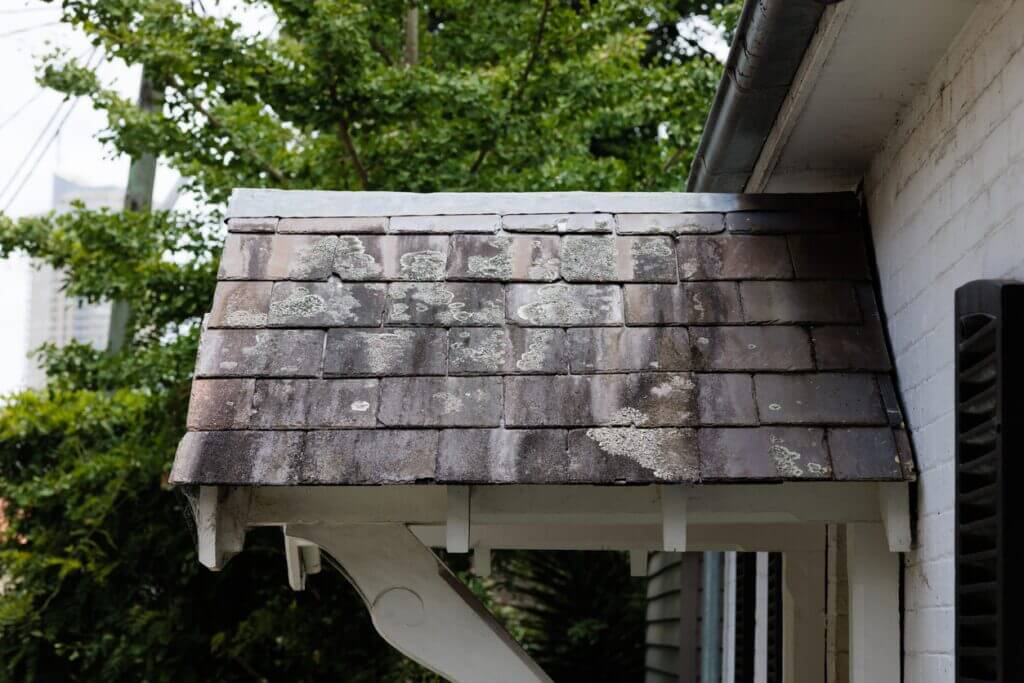
A leaky roof doesn’t always start with a dramatic hole overhead. More often, it creeps in quietly, the result of time, weather, and overlooked weak spots. Here’s what’s typically to blame when roof leaks start making an unwelcome appearance.
1. Aging Shingles and Materials
Roofs, like everything else, have a shelf life. Asphalt shingles, the most common roofing material, tend to last about 20-30 years. But Georgia’s sweltering summers and unexpected downpours can speed up wear and tear.
Over time, shingles crack, curl, or lose their protective granules, leaving your roof vulnerable to water infiltration.
If your home is pushing that 20-year mark and you’re spotting water stains or hearing the dreaded drip-drip, age could be the main culprit behind your leaky roof. It’s not always about dramatic storm damage; sometimes, it’s just the slow march of time.
2. Pipe Boot Failure
Pipe boots, a type of flashing that seals around plumbing vent pipes, tend to fly under the radar. But when they fail, they can be the source of major water leaks. Made of rubber or a rubber-metal combo, these components break down due to UV exposure and fluctuating temperatures.
Once cracked or brittle, they allow rainwater to slide right down the pipe into your attic or ceiling. If you’re calling someone for leak in roof repair, this is often one of the first places they’ll check.
3. Cracked Flashing Around Chimneys, Vents, or Dormers
Flashing is the thin metal sheet installed where different parts of your roof meet. It’s your roof’s version of caulking, a crucial detail that keeps moisture out of joints and crevices.
When flashing is improperly installed or starts to corrode or crack, you’ll notice it fast. Common problem areas include:
- Chimneys
- Roof vents
- Dormer windows
Any of these could be the source of that sneaky drip and may require professional roof leaking repair before it spreads to the interior structure.
4. Improper Sealing Near Valleys or Skylights
Roof valleys (where two slopes meet) and skylights are particularly leak-prone if they weren’t sealed with care during installation. A lazy seal job can let water funnel right into your attic rather than harmlessly down your gutters.
Tell-tale signs that poor sealing is at fault:
- Wet insulation near roof joints
- Water stains beneath skylights
- Leaks that only appear during heavy rain
These leaks usually aren’t visible from the ground, so by the time you spot them inside, they’ve already caused damage. In this case, patching a leaky roof might buy you time, but it won’t solve the underlying issue.
5. Clogged Gutters Backing up Water
Gutters clogged with leaves, pine needles, or Atlanta’s famous pollen can’t channel water away from your home properly. When that happens, water can pool and creep under shingles, especially near the roof’s edge.
Here’s how clogged gutters contribute to roof water leak repair needs:
- Overflow pushes water back up under shingles
- Soaked fascia boards and soffits rot over time
- Ice dams can form in colder months (yes, even in Georgia), worsening the problem
Keeping your gutters clean doesn’t just protect your landscaping; it helps prevent costly roof leakage repair down the road.
Signs of a Leaking Roof (Even If It’s Not Dripping Yet)
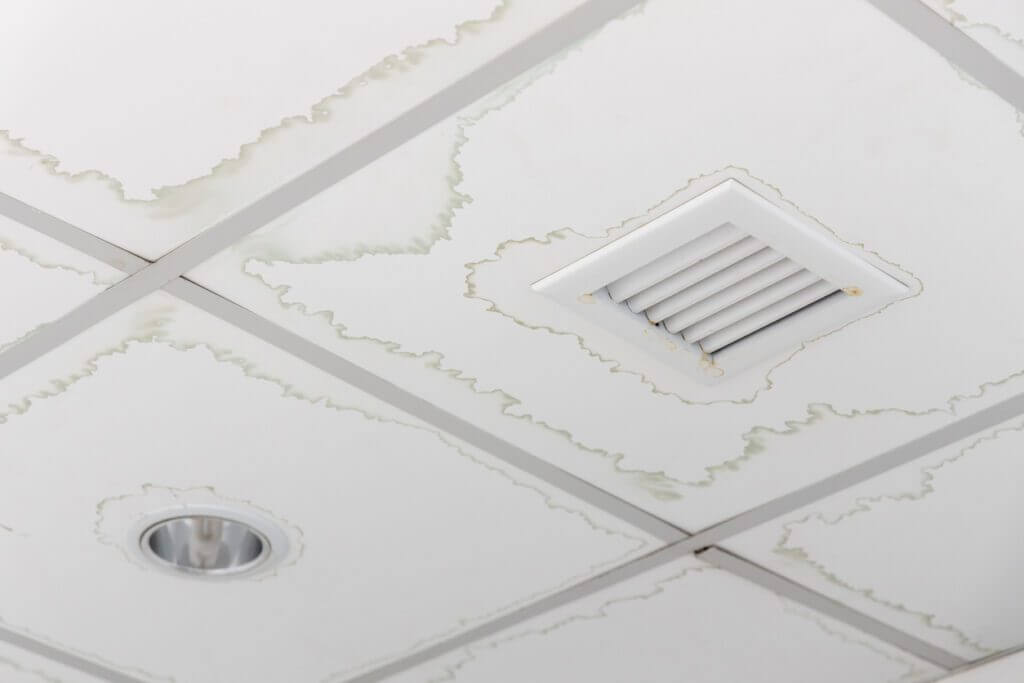
Not every leaky roof announces itself with an obvious drip. In fact, some of the worst leaks hide behind walls or ceilings until the damage is already done. That’s why catching early roof leak signs, before water starts pouring in, is key to minimizing the cost and hassle of roof leak repair.
Let’s break down the red flags that homeowners often miss until it’s too late.
Interior Indicators
You don’t need to climb on the roof to spot trouble. Sometimes, the warning signs are already inside your home, quiet but telling.
1. Ceiling Stains
Brownish, circular stains on your ceiling or upper walls aren’t just cosmetic issues, they’re water damage in disguise. They often show up near corners or light fixtures and tend to grow with each storm. If you’ve patched over one before and it’s reappeared, chances are you’ve got a leaky roof on your hands.
2. Paint Bubbling
When moisture sneaks into your walls or ceilings, paint reacts by bubbling, peeling, or blistering. That’s a clear sign that water is trapped underneath the surface, likely thanks to a hidden leak overhead. If you’re Googling how to fix leaking roof, bubbling paint is your cue to act quickly.
3. Warped Trim
Baseboards, crown molding, or window trim that suddenly looks bowed or rippled may be soaking up more than just humidity. Water that seeps in from the roof can trickle down interior walls, silently warping woodwork along the way. These subtle shifts are often the first indication of a deeper problem that may call for leaking roof repair.
Exterior Clues
You don’t need to be a roofing expert to spot surface-level problems from the ground. A quick visual check after a storm can reveal a lot.
1. Loose or Curling Shingles
Shingles should lie flat against your roof. If you spot any that are lifted, curled, or even missing, that’s a clear opening for water to get in. And once water finds a way through, even the best underlayment won’t hold it off for long. Addressing it early means you might only need a patching roof leak job, not a full overhaul.
2. Granules in Gutters
Asphalt shingles are coated with protective granules, and over time, they start to shed, especially in older roofs. If you’re finding large amounts of black, sand-like grit in your gutters or at the bottom of downspouts, your shingles are losing their defense against rain. It’s one of the most overlooked signs of a leak in roof repair situation waiting to happen.
Moldy Smells or Visible Dark Streaks in Attic Insulation
Head up to your attic (safely, please) and take a deep breath. If it smells musty or damp, there’s a good chance water has made its way in, even if you don’t see it yet.
You may also notice:
- Insulation that looks darker or matted down
- Wood beams with discoloration or soft spots
- A general humidity in the air that wasn’t there before
Mold and mildew thrive in dark, moist environments. And once they’ve moved in, they’re hard and expensive to evict. At this point, repair roof leaks becomes a race against mold remediation costs.
These warning signs often show up before water starts dripping through your ceiling. The benefit is that if you know what to look for, you can detect a leaky roof early and repair it before it escalates into structural damage or significant mold problems.
How to Stop Roof Leaks Temporarily (Until Help Arrives)
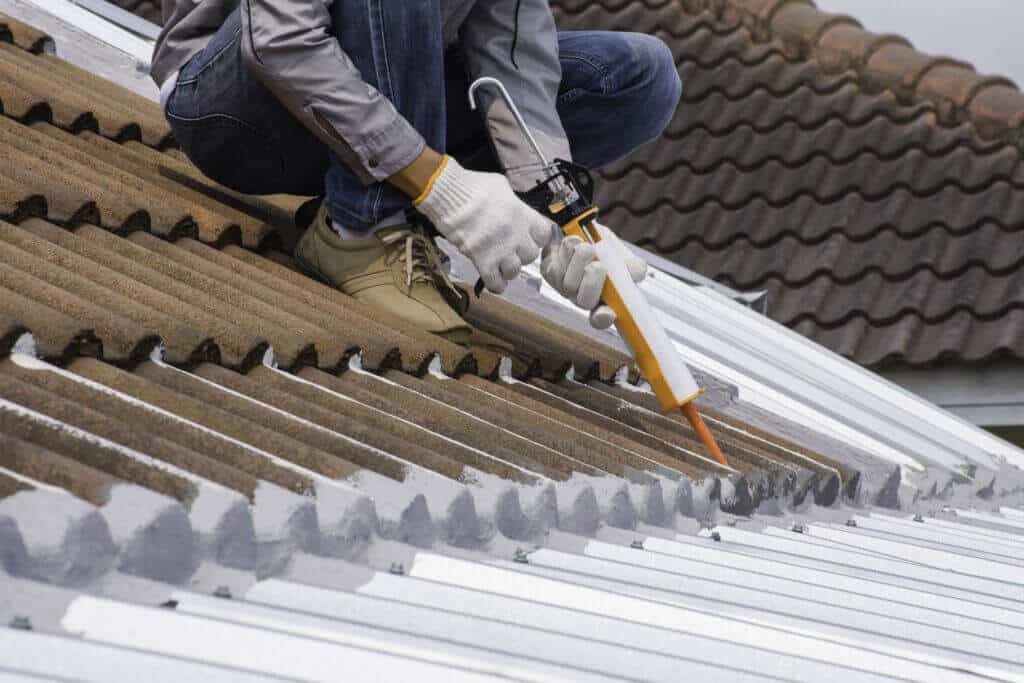
So, you’ve confirmed the worst: you’ve got a leaky roof, and water’s making its way inside. While you wait for the pros to arrive, and yes, you will want a professional, there are a few smart steps you can take to minimize the damage. Think of this as crisis control, not a permanent fix.
A Quick Safety Note
Before you head up a ladder with a tarp in one hand and determination in the other, take a moment to assess the situation. Wet roofs are slippery. Steep roofs are dangerous. Combine the two and you’ve got a DIY injury waiting to happen.
Unless it’s dry, safe, and you know what you’re doing, stay off the roof. There’s no shame in staying grounded and calling a professional for leaking roof repair, especially if your home has a high pitch or multiple stories.
Use of Tarp or Roofing Tape
If you’re comfortable working on the roof and the weather has cleared up, a tarp can be your best temporary defense. Here’s how:
Tarping a Leaky Roof:
- Choose a heavy-duty waterproof tarp (6 mil or thicker)
- Cover the damaged section with a few feet of overlap in every direction
- Secure it with roofing nails or weights (not just duct tape)
- If you spot the precise area of the leak, roofing tape or sealant can be used as a temporary patch
Keep in mind, this is just a short-term solution. Tarps and tape degrade under sun and wind. You’ll still need a qualified roofer to assess and handle permanent roof leakage repair.
Interior Containment
While the source of the leak gets a bandage, your interior needs attention too. Here’s how to reduce water damage inside your home:
|
Item |
Purpose |
|
Buckets |
Catch drips and reduce pooling on floors or carpets |
|
Towels |
Soak up water and protect hardwood or tile from becoming slippery |
|
Fans |
Promote air circulation and speed up drying of damp surfaces |
|
Dehumidifiers |
Pull moisture from the air to prevent mold and mildew growth |
Document Damage for Insurance
Before you mop up or move anything, grab your phone. Taking photos and videos of the leak, water stains, and any damaged belongings is critical if you plan to file a claim. Your insurer will want evidence, especially if you’re requesting reimbursement for roof water leak repair or damaged finishes.
Tips for documentation:
- Take wide shots of the affected room and close-ups of the leak
- Photograph ceiling stains, warped materials, and puddles
- Keep a list of damaged furniture, electronics, or flooring
Even if your roof repair ends up being straightforward, this documentation can save a lot of back-and-forth with your insurer down the road.
How to Repair a Leaking Roof (The Right Way)
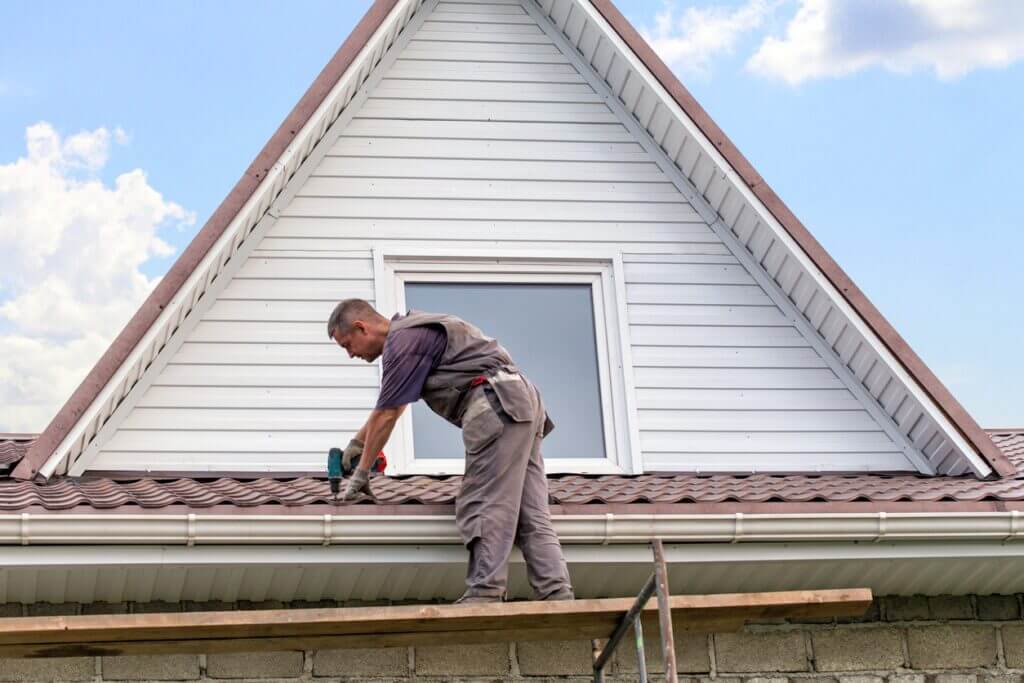
Roof systems are complex, and when done improperly, even small fixes can lead to big, expensive problems.
That said, understanding the general process of roof leaking repair helps you ask the right questions and know what to expect from your roofing contractor. Here’s how a leaky roof is typically repaired the right way.
Important: This is not a DIY guide. Use it as a smart homeowner’s roadmap, not a weekend project checklist.
1. Identify the Leak Source (Attic, Flashing, or Slope Entry)
Finding the true source of a leak is often the hardest part. That’s why pros start with a detailed inspection.
Common entry points include:
- Attic: Look for damp insulation, water stains, or moldy smells
- Flashing: Chimneys, skylights, and vents often have damaged or corroded flashing
- Roof slope: Valleys or ridges can develop cracks or gaps in sealing
An experienced roofer uses moisture meters, infrared tools, and plain old know-how to trace water to its entry point, not just where it shows up inside.
2. Remove Damaged Material
Once the leak source is confirmed, the next step is to strip away the affected layers. That includes:
- Damaged shingles or tiles
- Underlayment with water saturation
- Flashing or sealant that’s cracked or deteriorating
Removing compromised materials is essential before any leaky roof repair can hold. Covering over rotted decking or moldy underlayment is just kicking the problem down the road.
3. Replace Flashing or Shingles
With the problem area exposed and prepared, your roofer will replace the necessary materials. This step may involve:
- Installing new flashing around vents, chimneys, or skylights
- Replacing cracked or curled shingles with matching ones
- Reinforcing seams or valleys with additional waterproof underlayment
This is where craftsmanship matters. A patch job might look fine today, but if flashing isn’t installed with precision, you’ll be right back to searching “how to fix leaking roof” the next time it rains.
4. Seal and Recheck for Water Intrusion
Finally, your roofer will seal the repaired area using high-grade roofing cement, caulk, or sealants, depending on your roof type. Then, it’s time to test the repair.
A proper roofer may simulate rain or use water hoses to confirm that the leak is fully resolved. No shortcuts. No guesswork. That’s the difference between temporary relief and a permanent roof leakage repair.
The Dangers of DIY Roof Repairs
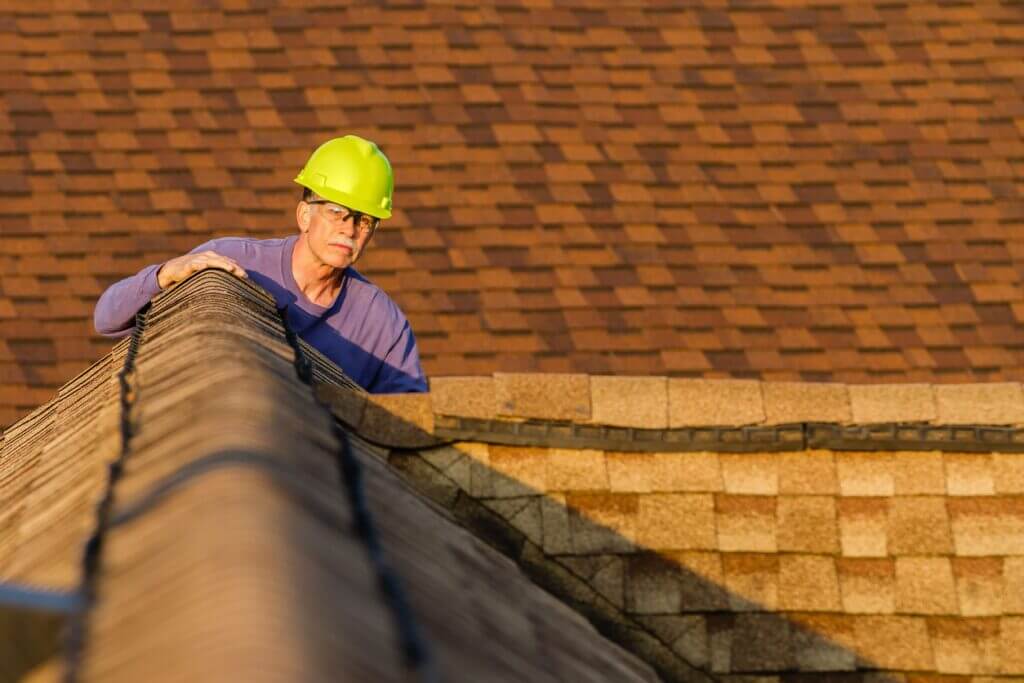
Fixing a leaky roof may look simple on the surface, but most DIY attempts lead to incomplete repairs, hidden damage, or even personal injury. Here’s why tackling roof leaking repair on your own often causes more harm than good.
Missed Secondary Leaks
Leaks rarely travel in straight lines. You may find and patch one entry point, but water could be entering from another area entirely. DIY fixes often fail to address secondary leaks, leaving your home vulnerable to ongoing water damage.
Incorrect Materials or Underlayment
Not all shingles, sealants, or underlayment materials are created equal. Using the wrong type, even by accident, can cause premature wear, poor sealing, or moisture buildup. Professional roofers know what materials your roof system needs to function properly.
Risk of Voiding Roof Warranties
Most roof warranties require that repairs be done by licensed professionals. A DIY attempt, even with good intentions, can void manufacturer coverage or insurance claims if future issues arise. One wrong move could cost you thousands later.
Safety Concerns (Especially on Steep or Wet Roofs)
Working on a sloped roof, especially after rain, is risky. Slips and falls are the leading cause of serious injuries in home repair projects. Roofing pros are trained and equipped to navigate steep or wet surfaces safely.
Why Calling a Pro—Like Mr. Roofer—Is Often the Safest and Most Cost-Effective Route
At the end of the day, professional leaky roof repair isn’t just about patching holes, it’s about protecting your home’s structure and value. A licensed roofer like Mr. Roofer doesn’t just fix the surface issue; we diagnose the full problem, apply the correct materials, and ensure the repair will last. That’s peace of mind you simply can’t get from a ladder and a caulk gun.
Conclusion
A leaky roof is a threat to your home’s integrity, comfort, and long-term value. While temporary fixes can buy you time, proper roof leakage repair demands expertise. From spotting early signs to sealing the source, knowing what to do and who to call can save you thousands in future repairs.
Need help with a roof leak in the Atlanta area? Contact Mr. Roofer today for a professional inspection and repair done right the first time. Because when it comes to your home, “good enough” just isn’t good enough.
